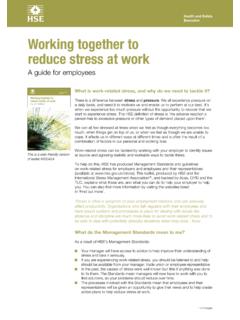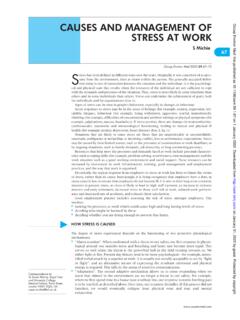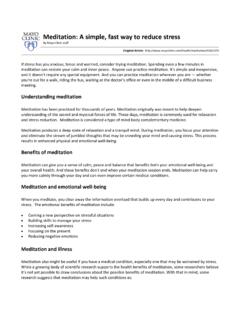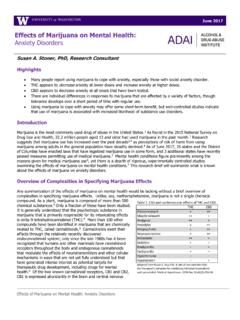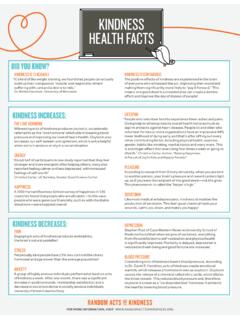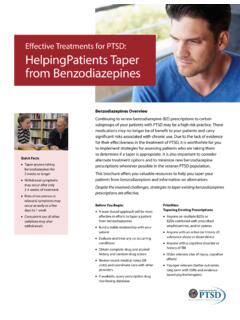Transcription of Mental Health and Stress in the Workplace
1 1 Workplace JULY 2018 Mental Health IN THE Mental Health Disorders and Stress Affect Working-Age Americans Mental Health disorders are among the most burdensome Health concerns in the United States. Nearly 1 in 5 US adults aged 18 or older ( or million people) reported any Mental illness in In addition, 71% of adults reported at least one symptom of Stress , such as a headache or feeling overwhelmed or Many people with Mental Health disorders also need care for other physical Health conditions, including heart disease, diabetes, respiratory illness, and disorders that affect muscles, bones, and 8 The costs for treating people with both Mental Health disorders and other physical conditions are 2 to 3 times higher than for those without co-occurring By combining medical and behavioral Health care services.
2 The United States could save $ billion to $ billion a About 63% of Americans are part of the US labor The Workplace can be a key location for activities designed to improve well-being among adults. Workplace wellness programs can identify those at risk and connect them to treatment and put in place supports to help people reduce and manage Stress . By addressing Mental Health issues in the Workplace , employers can reduce Health care costs for their businesses and employees. To learn more about Workplace Health , visit PROBLEM Mental Health Issues Affect Businesses and Their Employees Poor Mental Health and Stress can negatively affect employee: Job performance and productivity.
3 Engagement with one s work. Communication with coworkers. Physical capability and daily functioning. Mental illnesses such as depression are associated with higher rates of disability and unemployment. Depression interferes with a person s ability to complete physical job tasks about 20% of the time and reduces cognitive performance about 35% of the Only 57% of employees who report moderate depression and 40% of those who report severe depression receive treatment to control depression Even after taking other Health risks like smoking and obesity into account, employees at high risk of depression had the highest Health care costs during the 3 years after an initial Health risk.
4 14 Get the resources you need to start your own Workplace Health promotion program at 2 SOLUTION Employers Can PROMOTE Awareness About the Importance of Mental Health and Stress Management Workplace Health promotion programs have proven to be successful, especially when they combine Mental and physical Health interventions. The Workplace is an optimal setting to create a culture of Health because: Communication structures are already in place. Programs and policies come from one central team. Social support networks are available. Employers can offer incentives to reinforce healthy behaviors.
5 Employers can use data to track progress and measure the effects. Action steps employers can take include: Make Mental Health self-assessment tools available to all employees. Offer free or subsidized clinical screenings for depression from a qualified Mental Health professional, followed by directed feedback and clinical referral when appropriate. Offer Health insurance with no or low out-of-pocket costs for depression medications and Mental Health counseling. Provide free or subsidized lifestyle coaching, counseling, or self-management programs. Distribute materials, such as brochures, fliers, and videos, to all employees about the signs and symptoms of poor Mental Health and opportunities for treatment.
6 Host seminars or workshops that address depression and Stress management techniques, like mindfulness, breathing exercises, and meditation, to help employees reduce anxiety and Stress and improve focus and motivation. Create and maintain dedicated, quiet spaces for relaxation activities. Provide managers with training to help them recognize the signs and symptoms of Stress and depression in team members and encourage them to seek help from qualified Mental Health professionals. Give employees opportunities to participate in decisions about issues that affect job Stress . EMOTIONAL Health To get started today, visit the CDC Workplace Health Resource Center at 3 SUCCESS STORIES Many Businesses PROVIDE Employees With Resources to Improve Mental Health and Stress Management Prudential Financial15 Monitors the effect of supervisors on worker well-being, especially when supervisors change.
7 Conducts ongoing, anonymous surveys to learn about attitudes toward managers, senior executives, and the company as a whole. Normalizes discussion of Mental Health by having senior leadership share personal stories in video messages. TiER1 Performance Solutions16 Focuses on 6 key Health issues: depression, anxiety, obsessive-compulsive disorder, schizophrenia, bipolar disorder, and addictions as part of its Start the Conversation about Mental Illness awareness campaign. Provides resources to assess risk, find information, and get help or support using multiple formats to increase visibility and engagement.
8 For example, information is provided as infographics, e-mails, weekly table tents with reflections and challenges, and videos (educational and storytelling). Beehive PR17 Maintains the InZone, a dedicated quiet room that is not connected to a wireless internet signal, which gives employees a place to recharge. Combines professional and personal growth opportunities through goal-setting, one-on-one coaching, development sessions, and biannual retreats. Tripler Army Medical Center18 Requires resiliency training to reduce burnout and increase skills in empathy and compassion for staff members who are in caregiver roles.
9 Training sessions mix classroom-style lectures, role-playing, yoga, and improvisational comedy to touch on multiple learning styles. Certified Angus Beef19 Provides free wellness consultations by an on-site clinical psychologist. Employees do not have to take leave to access these services. Holds lunchtime learning sessions to reduce stigma about Mental Health and the services available to employees. Offers quarterly guided imagery relaxation sessions to teach Stress management strategies. Houston Texans20 Provides comprehensive and integrated physical, Mental , and behavioral Health insurance coverage, including round-the-clock access to employee assistance program (EAP) services.
10 Extends EAP access to anyone living in an employee s home, with dedicated programming for those who are caring for children or elderly parents. Get the resources you need to start your own Workplace Health promotion program at 4 What Can Be Done Strategies for Managing Mental Health and Stress in the Workplace Health care providers can: Ask patients about any depression or anxiety and recommend screenings, treatment, and services as appropriate. Include clinical psychologists, social workers, physical and occupational therapists, and other allied Health professionals as part of core treatment teams to provide comprehensive, holistic care.










